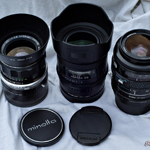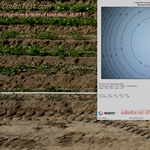35mm lens comparison, second round, Minolta 35/2.8 & Pentax FA35/2, on the Sony a7R.
After looking at some nice Minolta 35mm f/2.8 landscape pictures, your author wanted to see how that camera lens compared to the winner of the first round of 35mm prime lens comparison testing, on the Sony a7R.
As you might recall, that group of 35mm lenses turned into a battle of defects, with the Pentax FA35 emerging as the winner, despite being slightly decentered on one side. The Canon FDn 35/2.8 lens had potential, especially in the center, but it went down hard after it’s decentered left side failed to improve when stopped down to f/8.
This round of 35mm lens testing will again include a zoom lens; the venerable Minolta Maxxum AF 35-70mm f/4, mounted on a Fotasy AF-NEX adapter(no electrical contacts). That lens doesn’t have an aperture ring on it, but the adapter has a rotating collar, that actuates the aperture lever inside the lens. You can’t tell what aperture it’s actually at, so the leaves were opened to a midpoint position for the f/8 portion of the test.
The Minolta MC W.Rokker-HG 35/2.8 lens that was tested here was a pristine sample, complete with the factory felt-lined metal hood and metal cap. There was minimal dust, but the aperture leaves were oily, which didn’t appear to interfere with their operation. This is a nice piece of glass, it looks like one of the classic Pentax primes. It’s slightly smaller in diameter than the FA35.
The vignetting results, with some data from previous round:
Minolta 35mm, at f/2.8: 1/15th, -3.43(f-stops)
Pentax FA35, at f/2.0: 1/50th, -2.71(f-stops)
Canon FDn, at f/2.8: 1/30th, -2.99(f-stops)
The 100% corner crop photo from the Minolta lens at f/11, still shows issues in the deep corners.
Ease of focus at long distances: The Pentax FA35/2.0 wins again, but the little Minolta 35mm lens holds it’s own; if the Canon FDn were back in this round, it would be in third place, in part because it just feels cheaper than the other two lenses. That doesn’t seem to make sense, in the context of comparing a couple of autofocus lenses to these manual focus lenses, so at some level it’s a matter of personal preference. The Minolta 35-70mm zoom had usable manual focus here, but all of the lenses in this round were aided by slightly overexposing the image, while focusing on the “5610” street number.
Lens contrast: It’s pretty difficult to match exposures between lenses in the field, so that will influence the perception of contrast; nothing looks weak here, and in looking back at the Canon FDn 35/2.8 results, it’s difficult to pick an outright winner. However, at wide open apertures, the Minolta 35/2.8 has an old-skool glow to it, that looks like veiling haze, which knocks the contrast down. This camera lens takes big jumps in picture quality at f/5.6, ~f/7.1, and again at f/11. Those are full frame aperture numbers, equivalent depth of field on smaller sensors may not be at the same aperture numbers seen here. It’s the DOF increase that’s overcoming these design issues with this glass.
Sides of the images: *Wide open*: The lovely Minolta 35/2.8 is weak here, it’s blurry on both sides, with strong vignetting. The zoom is at f/4 of course, and you can almost read the “5620” address number on the left side with it. However, it’s showing signs of a wavy focus area on the right, so the Pentax FA35, shot at ~f/2.4, wins at wide open apertures. *f/10-f/11*: The zoom fails at all apertures, the right-side edge never cleans up, and neither does the wavy focus area. In past lens tests, f/8 was used as the judging point, but the Minolta 35/2.8 has a complex mustache focus area in the outer mid-zone areas, on both sides, that doesn’t clean up until f/11. You can see it in the “5620” number on the left, and also on the right side, where the red brick restaurant building lettering is. At closed-down apertures, it’s better on the left side than the left side of the decentered Pentax FA35 lens.
Center of the images: Everything looks usable here at landscape apertures, which appears to be standard fare with most lenses on the Sony a7R. As you close down the aperture on the Minolta 35/2.8, in order to overcome the field curvature and vignetting, watch out for diffraction artifacting in the center. You might be able to go beyond f/11, if the sides keep improving.
Summary: With this second round of 35mm lens testing, we now finally have a lens that’s not decentered; the Minolta MC W.Rokker-HG 35/2.8 lens can be judged on it’s design, not it’s build failures. The object of these tests has been to evaluate field curvature for landscape shooting at closed-down apertures, and the Minolta wins there over everything else, because the Pentax FA35/2.0 is decentered. Interestingly enough, the Minolta 35/2.4 lens also has slightly less CA than the Pentax FA35/2, when stopped down. However, lens design choices by Minolta resulted in weaknesses on the sides at open apertures, to the extent that it’s worse than the decentered Pentax FA35. Those heavy vignetting, field curvature, and veiling haze issues would also place it well behind the Canon FDn 35/2.8 lens at wider apertures.
Given all of the poor Q.C. by lens manufacturers, the take-home lesson here isn’t that one lens design is always going to be better than the other; the winner is more often going to be which lens is actually functioning at 100% design capacity.
Here are the test images, they are 16-17mb in size, **be sure and view at 100% size**:
Wide open aperture:
https://www.codectest.com/images/35mmlenstest2ndround-f28-MinoltaPentaxMinoltaZoom.jpg
~f/10-f/11 aperture:
https://www.codectest.com/images/35mmlenstest2ndround-f11-MinoltaPentaxMinoltaZoom.jpg
Dan Euritt




